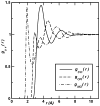Biomolecular electrostatics and solvation: a computational perspective
- PMID: 23217364
- PMCID: PMC3533255
- DOI: 10.1017/S003358351200011X
Biomolecular electrostatics and solvation: a computational perspective
Abstract
An understanding of molecular interactions is essential for insight into biological systems at the molecular scale. Among the various components of molecular interactions, electrostatics are of special importance because of their long-range nature and their influence on polar or charged molecules, including water, aqueous ions, proteins, nucleic acids, carbohydrates, and membrane lipids. In particular, robust models of electrostatic interactions are essential for understanding the solvation properties of biomolecules and the effects of solvation upon biomolecular folding, binding, enzyme catalysis, and dynamics. Electrostatics, therefore, are of central importance to understanding biomolecular structure and modeling interactions within and among biological molecules. This review discusses the solvation of biomolecules with a computational biophysics view toward describing the phenomenon. While our main focus lies on the computational aspect of the models, we provide an overview of the basic elements of biomolecular solvation (e.g. solvent structure, polarization, ion binding, and non-polar behavior) in order to provide a background to understand the different types of solvation models.
Figures




Similar articles
-
Computational methods for biomolecular electrostatics.Methods Cell Biol. 2008;84:843-70. doi: 10.1016/S0091-679X(07)84026-X. Methods Cell Biol. 2008. PMID: 17964951 Free PMC article.
-
Anisotropic solvent model of the lipid bilayer. 1. Parameterization of long-range electrostatics and first solvation shell effects.J Chem Inf Model. 2011 Apr 25;51(4):918-29. doi: 10.1021/ci2000192. Epub 2011 Mar 25. J Chem Inf Model. 2011. PMID: 21438609 Free PMC article.
-
Differential geometry based solvation model II: Lagrangian formulation.J Math Biol. 2011 Dec;63(6):1139-200. doi: 10.1007/s00285-011-0402-z. Epub 2011 Jan 30. J Math Biol. 2011. PMID: 21279359 Free PMC article.
-
Biomolecular Simulations with the Three-Dimensional Reference Interaction Site Model with the Kovalenko-Hirata Closure Molecular Solvation Theory.Int J Mol Sci. 2021 May 11;22(10):5061. doi: 10.3390/ijms22105061. Int J Mol Sci. 2021. PMID: 34064655 Free PMC article. Review.
-
Continuum molecular electrostatics, salt effects, and counterion binding--a review of the Poisson-Boltzmann theory and its modifications.Biopolymers. 2008 Feb;89(2):93-113. doi: 10.1002/bip.20877. Biopolymers. 2008. PMID: 17969016 Review.
Cited by
-
The electrostatic response of water to neutral polar solutes: implications for continuum solvent modeling.J Chem Phys. 2013 Jun 14;138(22):224504. doi: 10.1063/1.4808376. J Chem Phys. 2013. PMID: 23781802 Free PMC article.
-
Enriched gradient recovery for interface solutions of the Poisson-Boltzmann equation.J Comput Phys. 2020 Nov 15;421:109725. doi: 10.1016/j.jcp.2020.109725. Epub 2020 Jul 23. J Comput Phys. 2020. PMID: 32884156 Free PMC article.
-
Electrical impulse characterization along actin filaments in pathological conditions.Comput Phys Commun. 2022 Jun;275:108317. doi: 10.1016/j.cpc.2022.108317. Epub 2022 Feb 22. Comput Phys Commun. 2022. PMID: 35369107 Free PMC article.
-
Electrical Propagation of Condensed and Diffuse Ions Along Actin Filaments.J Comput Neurosci. 2022 Feb;50(1):91-107. doi: 10.1007/s10827-021-00795-4. Epub 2021 Aug 15. J Comput Neurosci. 2022. PMID: 34392446 Free PMC article.
-
Small molecule solvation changes due to the presence of salt are governed by the cost of solvent cavity formation and dispersion.J Chem Phys. 2014 Dec 14;141(22):22D518. doi: 10.1063/1.4900890. J Chem Phys. 2014. PMID: 25494789 Free PMC article.
References
-
- AAQVIST J. Ion-water interaction potentials derived from free energy perturbation simulations. The Journal of Physical Chemistry. 1990;94(21):8021–8024.
-
- ADAMS PL, STAHLEY MR, KOSEK AB, WANG JM, STROBEL SA. Crystal structure of a self-splicing group I intron with both exons. Nature. 2004;430(6995):45–50. - PubMed
-
- ALEJANDRE J, HANSEN J. Ions in water: From ion clustering to crystal nucleation. Physical Review E. 2007;76(6):061505. - PubMed
-
- ALLEN TW, KUYUCAK S, CHUNG SH. Molecular dynamics estimates of ion diffusion in model hydrophobic and KcsA potassium channels. Biophysical Chemistry. 2000;86(1):1–14. - PubMed
Publication types
MeSH terms
Substances
Grants and funding
LinkOut - more resources
Full Text Sources

